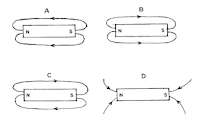BECE questions on force and pressure
A. BECE Questions on Force
Objectives - Section A
1. Which of the following is not true about frictional force? It
A. increases motion
B. opposes motion
C. damages machines
D. produces heat
E. decreases efficiency of machines
A. gravitational force
B. frictional force
C. magnetic force
D. electrostatic force
E. Force due to tension
3. What is the work done when a force of 2.5 N moves through a distance of 4 m?
A. 0.6 J
B. 1.5 J
C. 1.6 J
D. 6.5 J
E. 10.0 J
4. In a simple machine, the force that is applied to enable work to be done is known as
A. Lever
B. Load
C. Pivot
D. Effort
E. Hinge
5. The force which acts between planets and keeps them in their orbits is called
A. electrical force
B. magnetic force
C. gravitational force
D. frictional force
E. elastic force
A. accompanies motion
B. acts against motion
C. causes motion
D. makes motion easy
E. is created by motion
7. The force which is able to hold light objects on the surface of liquids is called
A. surface tension
B. friction
C. capillarity
D. viscosity
E. cohesion
8. A boy exerts a force of 40.0 N to lift a load into a vehicle. If the work done is 80.0 J, calculate the distance through which the load is lifted.
A. 0.5 m
B. 2.0 m
C. 40.0 m
D. 120.0 m
E. 3200.0 m
9. The force overcome by a machine is known as the
A. effort
B. load
C. pivot
D. lever
E. work
10. Most machines waste energy because of
A. old age
B. force
C. friction
D. load
E. too much effort
11. The weight of an object is the
A. force with which the sun pulls it
B. force with which the moon pulls it
C. force of the object when gravity is not acting on it
D. force with which gravity acts on it
E. mass of the object
12. How much work is done when a kerosene tin is pushed with a force of 20 N through a distance of 2 m?
A. 0.01 J
B. 0.10 J
C. 10.0 J
D. 20.0 J
E. 40.0 J
13. Which of the following forces will cause an object to move in a circular path?
A. Centripetal force
B. Gravitational force
C. Inertial force
D. Reaction force
E. Tensional force
I. It causes moving objects to stop
II. It causes stationary objects to move
III. It can change the direction of motion
IV. It can change the shape of an object
A. I and II only
B. III and IV only
C. I, II and III only
D. I, II, III and IV
15. Electricity is used by appliances to do work. This means that electricity is a form of
A. energy
B. force
C. generator
D. machine
16. A force of 2N moves a body through a distance of 10 m. Calculate the work done.
A. 5 J
B. 8 J
C. 12 J
D. 20 J
17. When a person jumps up, he/she is able to come down because of the
A. pull of the earth’s gravitational force
B. pull of the earth’s magnetic force
C. resistance of the earth’s atmosphere to the upward motion
D. pressure of the earth’s atmosphere on the person
18. The joule is the S.I unit for
A. energy
B. force
C. power
D. pressure
19. The S.I. unit for measuring the work done by a force is
A. J.
B. K.
C. N.
D. W.
20. The force which tends to pull an object in a circular motion towards the centre of the circle is called
A. centripetal force
B. electrostatic force
C. gravitational force
D. magnetic force
21. Which of the following illustrations shows the correct direction of the lines of force around a bar magnet?
22. At which positions S, R, Q and P on the lever in the diagram below must a force be applied to lift the load most easily?
A. adhesion B. cohesion C. tension D. viscosity
A. frictional force
B. electrostatic force
C. gravitational force
D. rotational force
A. energy
B. force
C. work
D. power
A. adhesion
B. cohesion
C. capillary action
D. surface tension
A. There was no friction
B. The ground was hard
C. The banana peel was soft
D. The ground was sandy
E. The frictional force was too great
A. The force acts in the opposite direction
B. The wall does not move
C. The force is in the same direction
D. The material of the wall is strong
E. The force is in horizontal direction
29. Which of the following forces tends to pull forces towards the centre of the earth?
A. Electrostatic force
B. Magnetic force
C. Force of gravity
D. Force of attraction
E. Centrifugal force
30. The force, which opposes the motion of one body on another body is called
A. adhesion
B. cohesion
C. friction
D. tension
32. The work done when a force moves a body through a distance of 12 m is 720 J. The force applied is
A. 8640 N B. 732 N C. 708 N D. 60 N
33. A drawing of magnetic lines of force provides information on the
A. source of the field
B. type of magnet
C. strength of the field
D. length of the magnet
34. Which of the following statements about machines is/are correct?
I. Machines help us to do work more easily
II. A force applied at one point of the machine overcomes a load at another point of the machine
III. All machines have engines
A. I only
B. II only
C. III only
D. I and II only
E. II and III only
Essay type Questions - Section B
1. (i) Name four types of forces.
(ii) A boy used a catapult to pluck a mango from a tree. State two forces involved in this activity.
(iii) Where are the forces in (b) (ii) applied? [BECE 1992]
2. A bag of cement is pulled along a smooth horizontal floor with a horizontal force of 1000 N. If the work done is 100,000 J, calculate the distance through which the bag is pulled.[BECE 1992]
3. (i) Define the term force
(ii) State three types of force
(iii)
A box is pulled by a force of 20 N through a distance of 8m
along a smooth floor. Calculate the work done by the force. [BECE 1994]
4. An amount of 300.0 J of work is done when a force moves through a distance of 10.0 m in the direction of the force. Calculate the value of the force.[BECE 1996]
5. (i) A boy pulled a load through a distance
of 5 m. If he exerts a force of 15 N in the direction of the force,
calculate the work done
(ii) Convert the following weights expressed in kilogram force (kgf) to newton (N)
(α) 0.75 kgf
(β) 1.33 kgf
[1kgf = 10N] [BECE 2000]
6. (a) What is an electrostatic force?
(b) (i) State the unit of
(α) force
(β) work [BECE 2000]
7. A block of mass 10kg is suspended from a spring. Calculate the force acting on the block. [g = 10ms-2] [BECE 2001]
8. (i) Name four types of forces.
(ii) A boy
used a catapult to kill a bird which was on a tree and it fell to the
ground. Give two forces involved in this process [BECE 2004]
9. (i) Name four types of forces.
(ii) A boy
used a catapult to kill a bird which was on a tree and it fell to the
ground. Give two forces involved in this process [BECE 2005]
10. (i) Name four types of forces apart from friction.
(ii) Give three effects of a force [7 marks] [BECE 2009]
11. (i) What is a force?
(ii) Explain briefly why a driver a could not stop a car on a slippery section of a road when he applied the brake. [BECE 2019]
12. (i) What is a force?
(ii) Explain briefly why a driver a could not stop a car on a slippery section of a road when he applied the brake. [BECE 2011]
13. (a) (i) What is a force?
(ii) A force of 200 N is exerted on an area of 50 m2.
Calculate the pressure exerted by the force. [3 marks] [BECE 2017]
15.(i) A steel needle carefully placed on the surface of water floats. What type of force made the steel needle to float?
(ii) Name three substances that could be added to the water to make the steel needle to float. [ BEEC 2014]
B. BECE Questions on Pressure
Objectives - Section A
A. a thermometer
B. a force meter
C. a barometer
D. an anemometer
A. A thermometer
B. An anemometer
C. A barometer
D. A hydrometer
E. A hygrometer
3. Which of the following environmental factors increases sweating in humans?
A. Low temperature
B. Low pressure
C. High pressure
D. High temperature
E. High humidity
4. When matter changes state from gas to liquid there is
A. a decrease in mass
B. a decrease in volume
C. an increase in pressure
D. an increase in temperature
A. pull of the earth’s gravitational force
B. pull of the earth’s magnetic force
C. resistance of the earth’s atmosphere to the upward motion
D. pressure of the earth’s atmosphere on the person
I. Water pumps
II. Syringes
III. Bicycle brakes
A. I only
B. I and II only
C. II and III only
D. I, II and III
A. acts differently in all directions
B. acts upwards at any point
C. decreases with depth
D. increases with depth
Essay type BECE questions on Pressure
1. Describe an experiment to show that pressure acts in all directions in a liquid
2. (i) Define pressure.
(ii) A force of 200 N is exerted on an area of 50 m2.
Calculate the pressure exerted by the force. [3 marks] [BECE 2017]
You Might Also Like




.webp)







No comments: